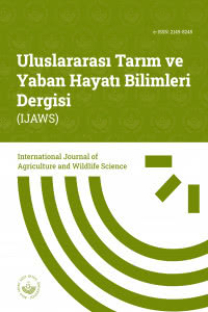The Effect of Seasonal Variation on Rosmarinus officinalis (L.) Essential Oil Composition
Rosmarinus officinalis, GC-MS, seasonal variation, volatile compounds
Mevsimsel Varyasyonun Rosmarinus officinalis (L.) Uçucu Yağ Bileşenlerine Etkisi
Rosmarinus officinalis, GC-MS, mevsimsel varyason, uçucu bileşen,
___
- Ait‐Ouazzou A., Lorán S., Bakkali M., Laglaoui A., Rota C., Herrera A., Pagan R and Conchello P., 2011. Chemical composition and antimicrobial activity of essential oils of Thymus algeriensis, Eucalyptus globulus and Rosmarinus officinalis from Morocco. Journal of the Science of Food and Agriculture, 91: 2643-2651.
- Anonymous 2016. Kahramanmaraş Meteoroloji İstasyonu Verileri. Arnold N., Valentini G., Bellomaria B and Hocine L., 1997. Comparative study of the essential oils from Rosmarinus eriocalyx Jordan & Fourr. from Algeria and R. officinalis L. from other countries. Journal of Essential Oil Research, 9: 167-175.
- Başkaya Ş., Ayanoğlu F ve Bahadırlı NP., 2016. Biberiye (Rosmarinus officinalis L.) bitkisinin uçucu yağ oranı, uçucu yağ bileşenleri ve antioksidan içeriğinde morfogenetik ve ontogenetik varyabilite. Mustafa Kemal Üniversitesi Ziraat Fakültesi Dergisi, 21:12-20.
- Celiktas OY., Kocabas EH., Bedir E., Sukan FV., Ozek T and Baser KHC., 2007. Antimicrobial activities of methanol extracts and essential oils of Rosmarinus officinalis, depending on location and seasonal variations. Food Chemistry, 100: 553-559.
- Del Pilar Sánchez-Camargo A and Herrero M., 2017. Rosemary (Rosmarinus officinalis) as a functional ingredient: recent scientific evidence. Current Opinion in Food Science, 14: 13-19.
- Diab Y., Auezova L., Chebib H., Chalchat JC and Figueredo G., 2002. Chemical composition of Lebanese rosemary (Rosmarinus officinalis L.) essential oil as a function of the geographical region and the harvest time. Journal of Essential Oil Research, 14: 449-452.
- Gülbaba AG., Özkurt N., Kürkçüoğlu M ve Başer KHC., 2002. Mersin ve Adana yöresindeki doğal biberiye (Rosmarinus officinalis L.) populasyonlarının tespiti ve uçucu yağ verim ve bileşimlerinin belirlenmesi. Orman Bakanlığı Teknik Bülten, 193: 5-30.
- Gürbüz B., Bağdat RB., Uyanik M and Rezaeieh KAP., 2016. Rosemary (Rosmarinus officinalis L.) cultivation studies under Ankara ecological conditions. Industrial Crops and Products, 88: 12-16.
- Jamshidi R., Afzali Z and Afzali D., 2009. Chemical composition of hydrodistillation essential oil of rosemary in different origins in Iran and comparison with other countries. American-Eurasian Journal of Agricultural & Environmental Sciences, 5: 78-81.
- Jordán MJ., Lax V., Rota MC., Lorán S and Sotomayor JA., 2013. Effect of bioclimatic area on the essential oil composition and antibacterial activity of Rosmarinus officinalis L. Food Control, 30: 463-468.
- Karagöktaş D and Yakupoğlu T., 2014. Erozyon araştırma sahasına dönüştürülmesi planlanan bir alanda aşınabilirlik ve toprak özellikleri arasındaki ilişkiler. Toprak Bilimi ve Bitki Besleme Dergisi, 2: 6-12.
- Kirpik M., 2005. Evaluating qualitative rosemary (Rosmarinus officinalis L.) lines growing in arid soils of cukurova region. Doctoral dissertation, Ph. D. thesis, Cukurova University Institute of Science, Adana.
- Orhan I., Aslan S., Kartal M., Şener B and Başer KHC., 2008. Inhibitory effect of Turkish Rosmarinus officinalis L. on acetylcholinesterase and butyrylcholinesterase enzymes. Food Chemistry, 108: 663-668.
- Özcan MM and Chalchat JC., 2008. Chemical composition and antifungal activity of rosemary (Rosmarinus officinalis L.) oil from Turkey. International Journal of Food Sciences and Nutrition, 59: 691-698.
- Papageorgiou V., Gardeli C., Mallouchos A., Papaioannou M and Komaitis M., 2008. Variation of the chemical profile and antioxidant behavior of Rosmarinus officinalis L. and Salvia fruticosa Miller grown in Greece. Journal of Agricultural and Food Chemistry, 56: 7254-7264.
- Pintore G., Usai M., Bradesi P., Juliano C., Boatto G., Tomi F and Casanova J., 2002. Chemical composition and antimicrobial activity of Rosmarinus officinalis L. oils from Sardinia and Corsica. Flavour and Fragrance Journal, 17: 15-19.
- Porte A., Godoy Rldo, Lopes D., Koketsu M., Gonçalves S and Torquilho HS., 2000. Essential oil of Rosmarinus officinalis L. (rosemary) from Rio de Janeiro, Brazil. Journal of Essential Oil Research, 12: 577-580.
- Satyal P., Jones TH., Lopez EM., McFeeters RL., Ali NAA., Mansi I and Setzer WN., 2017. Chemotypic characterization and biological activity of Rosmarinus officinalis. Foods, 6: 2-15.
- Tak JH., Jovel E and Isman MB., 2016. Comparative and synergistic activity of Rosmarinus officinalis L. essential oil constituents against the larvae and an ovarian cell line of the cabbage looper, Trichoplusia ni (Lepidoptera: Noctuidae). Pest Management Science, 72: 474-480.
- Tawfeeq A., Culham A., Davis F., Reeves M and Michael N., 2016. The influence of genetic variation on essential oil composition in Rosmarinus officinalis L. the common rosemary. 9th Joint Natural Products Conference, 24-27 July, Copenhagen, Denmark. Tisserand R and Young R., 2012. Essential Oil Safety. Churchill Livingstone Elsevier 2nd Edition, China.
- Topal U., Sasaki M., Goto M and Otles S., 2008. Chemical compositions and antioxidant properties of essential oils from nine species of Turkish plants obtained by supercritical carbon dioxide extraction and steam distillation. International Journal of Food Sciences and Nutrition, 5: 619-634.
- ISSN: 2149-8245
- Başlangıç: 2015
- Yayıncı: BOLU ABANT İZZET BAYSAL ÜNİVERSİTESİ > ZİRAAT VE DOĞA BİLİMLERİ FAKÜLTESİ
Fındığın Tepe Daldırması Yöntemi ile Çoğaltılması
The Effect of Seasonal Variation on Rosmarinus officinalis (L.) Essential Oil Composition
Bahtiyar Buhara Yücesan, İsmail Eker, Noreen Aslam, Luiz Eduardo Santos Lazzarini, Aliyu Mohammed, Jose Eduardo Brasil Pereira Pinto, Wolfgang Kreis, Ekrem Gürel
ABDURRAHMAN SAMİ KOCA, MUSTAFA İMREN, Halil KÜTÜK
Mevsimsel Varyasyonun Rosmarinus officinalis (L.) Uçucu Yağ Bileşenlerine Etkisi
Türkiye’deki Yerel Phaseolus vulgaris Populasyonlarını Kullanarak Kuru Fasulye Çeşitlerinin Islahı
Mehmet Zahit Yeken, Faik Kanta, Hüseyin Çancı, Göksel Özer, Vahdettin Çiftçi
Bahattin KARAKUŞ, BİLAL KESKİN
Mustafa KAPLAN, Ahmet Şafak MALTAŞ
Türkiye’de Organik Antepfıstığı Yetiştiriciliği ve Geliştirme Olanakları Üzerine Bir Derleme
